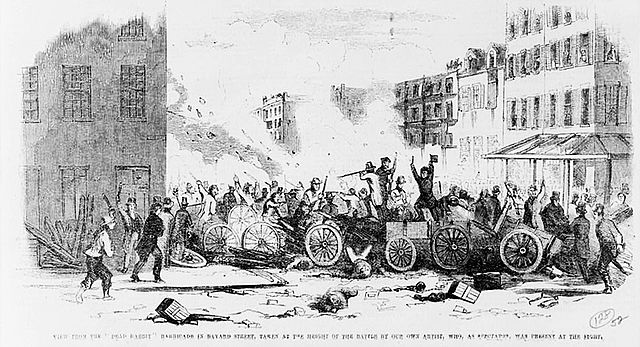The Dead Rabbits was the name of an Irish American criminal street gang active in Lower Manhattan in the 1830s to 1850s. The Dead Rabbits were so named after a dead rabbit was thrown into the center of the room during a gang meeting, prompting some members to treat this as an omen, withdraw, and form an independent gang. Their battle symbol was a dead rabbit on a pike. They often clashed with Nativist political groups who viewed Irish Catholics as a threatening and criminal subculture. The Dead Rabbits were given the nicknames of "Mulberry Boys" and the "Mulberry Street Boys" by the New York City Police Department because they were known to have operated along Mulberry Street in the Five Points.
Dead Rabbit holding a brickbat as a weapon in July 1857
A view of the fight the between two gangs, the "Dead Rabbits" and the "Bowery Boys" in the Bowery during the Dead Rabbits Riot of 1857.
George Henry Hall, artist painting A Dead Rabbit, 1858; also entitled Study of the Nude or Study of an Irishman, it depicts a dead Dead Rabbit, killed during the riot on July 4, 1857, in the Lower East Side.
The Bowery Boys were a nativist, anti-Catholic, and anti-Irish criminal gang based in the Bowery neighborhood of Manhattan, New York City in the early-mid-19th century. In contrast with the Irish immigrant tenement of the Five Points, the Bowery was a more prosperous working-class community. Despite its reputation as one of the most notorious street gangs of New York City at the time, the majority of the Bowery Boys led law-abiding lives for the most part. The gang was made up exclusively of volunteer firemen—though some also worked as tradesmen, mechanics, and butchers —and would fight rival fire companies over who would extinguish a fire. The Bowery Boys often battled multiple outfits of the infamous Five Points, most notably the Dead Rabbits, with whom they feuded for decades. The uniform of a Bowery Boy generally consisted of a stovepipe hat in variable condition, a red shirt, and dark trousers tucked into boots—this style paying homage to their fireman roots.

Bowery Boy of New York City in 1857
Moses Humphrey, a Bowery grocer, was the inspiration for Mose the Fireboy, the quintessential Bowery B'hoy folk hero
Bowery Theatre, the Bowery, Manhattan, New York City
The interior of the Bowery Theatre







